Abstract
Focusing on the Lower Bari Doab Canal (LBDC) command area, characterized by its heavy reliance on agriculture, this study addresses the critical issue of groundwater table fluctuations in response to diverse pumping scenarios. Herein, we comprehensively evaluated the dynamic interplay between crop water requirements and groundwater pumping within the expansive canvas of the LBDC, which is facing water shortages. Using the Penman–Monteith equation, we calculated annual average evapotranspiration for major crops—wheat, maize, cotton, rice, and sugarcane. Three-dimensional MODFLOW-based numerical modeling was used to analyze the dynamics of groundwater regimes. MODFLOW was calibrated from 2010 to 2020. Thereafter, we simulated water table changes under a 20% increase and decrease in groundwater extraction up to 2040s. Results revealed significant variations in water demands among these crops, with sugarcane requiring the highest average annual evapotranspiration at 1281 mm. Spatiotemporal analysis revealed substantial declines in the water table in the tail-end command areas, particularly Sahiwal and Khanewal where the decline was 0.55 m/year between 2010 and 2020. The upper reaches, such as Balloki and Okara, experienced milder declines. In considering management scenarios, a 20% increase in groundwater extraction up to September 2040 was projected to raise pumping to 4650 MCM/year. and decrease the net water balance to −235 MCM/year. Alternatively, a 20% decrease in groundwater extraction up to September 2040 could reduce pumping to 4125 MCM/year and increase the net water balance to 291 MCM/year. This study sheds light on major crop water requirements, spatiotemporal groundwater dynamics, and the implications of groundwater extraction in the LBDC command area. Scenarios presented here, encompassing increased and decreased groundwater extraction, offer invaluable guidance for policymakers and stakeholders seeking a balance between agricultural productivity and long-term groundwater sustainability.
1. Introduction
Groundwater, a critical component of Earth’s hydrological cycle, plays a pivotal role in sustaining both natural ecosystems and human livelihoods worldwide [1,2,3,4]. Over 40% of the world’s food requirements are dependent on irrigated areas, utilizing around 70% of the water for agriculture [5]. Globally, groundwater extraction has witnessed an unprecedented surge, accounting for approximately 42% of the world’s irrigation supplies [6,7,8] and irrigating 113Mha of the world’s irrigated land [8]. Groundwater extractions will increase by 39% by 2050 [9]. Global groundwater reserves are increasingly vulnerable to the multifaceted consequences of climate change and human interventions [10,11,12,13]. Prolonged droughts and altered precipitation patterns are causing reduced groundwater recharge rates, making aquifers less resilient to extraction demands [14,15]. Simultaneously, escalating human populations and burgeoning agricultural practices exert relentless pressure on these finite subsurface resources [16,17,18,19,20]. Prolonged groundwater depletion can exacerbate drought conditions, further intensifying water scarcity challenges in already arid regions [17,21]. The heightened reliance on groundwater for agriculture and drinking water has profound implications, not only for the sustainability of local aquifers but also for the broader environment and climate dynamics.
Within the context of the Indus Basin Irrigation System (IBIS), which encompasses a vast and intricate irrigation network in Pakistan, groundwater depletion stands as a pressing concern [22,23,24,25,26,27]. The historical imbalance in surface water distribution, aggravated by the geopolitical context of the region, has disproportionately affected the availability of water resources in the region [28]. The major area of IBIS is located under arid to semi-arid conditions with an annual average rainfall of 250–500 mm [29,30]. Only 15% of water requirements are met by direct rainfall and the remaining agricultural needs are met by surface and groundwater irrigation [31]. Because Pakistan’s surface water resources are limited, groundwater is frequently used to fill the gap between crop water demands and supplies [32,33,34]. About 70% of the overall irrigation water requirements are fulfilled by groundwater while the remaining are met by surface water supplies [35]. However, this heightened reliance on groundwater has caused widespread decline in aquifers, adversely affecting their sustainability [24,36]. Therefore, recognizing the far-reaching implications of this trend, effective groundwater management within IBIS is imperative. It entails not only ensuring equitable water allocation but also necessitates innovative strategies to enhance recharge, reduce extraction, and optimize agricultural water use.
To comprehend and manage groundwater systems effectively, a combination of advanced monitoring and modeling techniques has proven indispensable [37]. Groundwater monitoring encompasses diverse approaches, including in situ observations through wells, boreholes, and piezometers, which provide crucial data on water table depths, aquifer properties, and water quality parameters [38,39,40]. However, the key limitation of point-based monitoring lies in its limited spatial coverage and inability to capture the intricate dynamics of large-scale groundwater systems comprehensively. Alternatively, numerical modeling approaches have emerged as pivotal tools for simulating groundwater behaviors across extensive regions [41,42,43]. In the realm of groundwater hydrology, numerical modeling has emerged as an indispensable tool, offering comprehensive insights into the behavior of subsurface water resources [44]. These models employ mathematical algorithms to represent the complex interactions governing groundwater flow [45], solute transport, and aquifer response [46,47]. Various numerical models have been developed to simulate groundwater flow and solute transport, including FEFLOW, GMS, HydroGeoSphere, and MODFLOW, among others [18,19,36,48]. Reference [49] used different numerical models to investigate flow and solute transport in geological reservoirs. Reference [50] analyzed the impacts of groundwater extraction on land subsidence. Reference [51] used MODFLOW coupled with SWAT (Soil Water Assessment Tool) and space observations to estimate the groundwater depletion on basin-scale. Reference [52] delineated potential groundwater recharge in the Limpopo River Basin using integrated SWAT-MODFLOW [53]. Hydro geo-spheres have used for modeling groundwater abstraction of wide basins. Each of these models possesses its unique features and capabilities, making them suitable for specific applications [54]. Among them, MODFLOW, a robust numerical modeling platform, stands out as a preeminent choice due to its ability to simulate intricate groundwater flow patterns, incorporate geological heterogeneity, and address varying boundary conditions, making it particularly suited for assessing groundwater dynamics in large-scale and hydro-geologically complex settings [55].
Numerous studies have undertaken comprehensive investigations into aquifer dynamics across various regions within the Indus Basin Irrigation System (IBIS), as evidenced by the works of [56,57,58,59,60]. These rigorous studies have diligently examined groundwater dynamics in both urban and agricultural areas, providing valuable insights predominantly from historical perspectives. Nevertheless, it is noteworthy that these investigations have primarily focused on historical perspectives, omitting considerations of potential future scenarios of water abstractions. Moreover, their attention to groundwater budget accounting, particularly with regard to the vast irrigated canal command area, remains somewhat limited. Hence, there exists an imperative need to expand the scope of research in this domain, encompassing future water abstraction scenarios and a comprehensive assessment of the groundwater budget, especially in the context of large-scale irrigation systems like IBIS.
Our study addresses a critical knowledge gap by comprehensively examining the dynamic interaction between crop water requirements and groundwater pumping within the water-scarce agricultural region of Punjab, Pakistan. Employing the Penman–Monteith equation to calculate crop evapotranspiration and subsequently integrating these estimations into numerical simulations using visual MODFLOW 2011, we pursue three primary objectives. Firstly, we aim to illuminate the pivotal role of crop water demands in shaping groundwater dynamics. Secondly, we explore the potential impacts of varying water abstraction scenarios on groundwater resources. Thirdly, our study endeavors to provide evidence-based insights for sustainable water resource management within the water-scarce agricultural region. By revealing the intricate interdependency of crop water needs and groundwater pumping, our findings offer crucial guidance for policymakers, irrigation operators, and agricultural stakeholders. These insights hold promise in guiding strategic decisions related to water allocation, optimized irrigation schedules, and the prevention of groundwater exploitation, thereby contributing significantly to the sustainable management of this vital natural resource within the IBIS.
2. Materials and Methods
2.1. Study Area
The LBDC command is the Irrigated Indus Basin, covers a culturable command area (CCA) of 0.70 million hectares. The LBDC main canal is 201 km long with 2264 km of total length of distribution channel that offtakes from the river Ravi at Balloki headworks (Figure 1). It has a designed flow of 278 m3/s. From 1911 to 1913, the irrigation system was designed with equitable canal supplies over the command, for 67% cropping intensity, which has steadily increased to 150% and in some areas even up to 180%. Surface elevation for the study area ranges from 199 m in Balloki to 115 m. The dominant part of the LBDC command is located in an arid to semi-arid climate zone where the annual average rainfall is below 250 mm/year and the temperature touches above 45 °C during summer. Two cropping seasons exist in the area, i.e., Rabi season (April–September) and Kharif season (October–March). Wheat is the major crop sown in the area along with fodder, while cotton, maize, and rice are the major crops of the Kharif season.
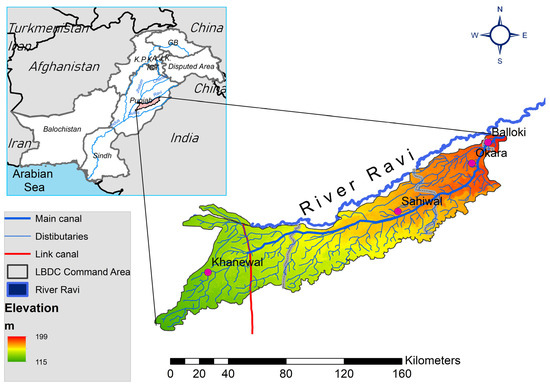
Figure 1.
Lower Bari Doab Canal (LBDC) command.
2.2. Research Framework
We have calculated the crop water requirements for the five major crops (wheat, rice, cotton, maize, and sugarcane) cultivated in the study area by employing the Penman–Monteith governing equation. Subsequently, we determined the net irrigation requirement. To assess groundwater level dynamics, we employed a finite difference three-dimensional groundwater model. Additionally, we have explored practical management scenarios involving increased or decreased groundwater extractions. The research framework adopted to accomplish our research objectives and elaborated in detail is presented in Figure 2.
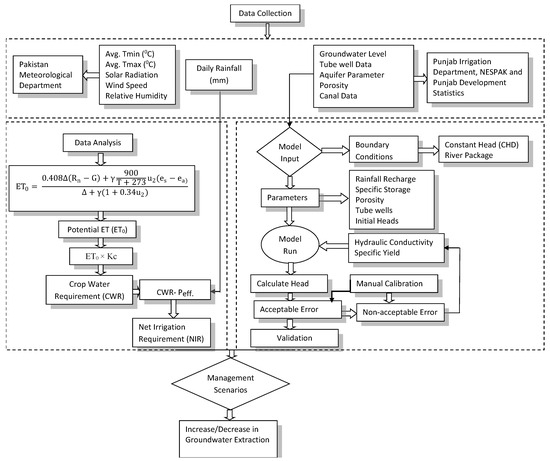
Figure 2.
Methodology flow chart.
2.2.1. Data Collection
To accomplish the study objectives, two distinct sets of data were collected. The first dataset comprised meteorological data necessary for calculating the crop water requirement of the major crops cultivated within the study area. This dataset encompassed variables such as maximum and minimum temperatures, rainfall, solar irradiance, and relative humidity. We collected data from meteorological stations installed in Okara and Sahiwal districts. For estimating data in other zones, the Inverse Distance Weighting (IDW) technique was applied, utilizing data from stations located within the study area and in proximity to the command area, such as Lahore and Multan. The second dataset encompassed information pertinent to the groundwater model. This set included groundwater levels observed during both pre-monsoon and post-monsoon seasons, river stage data for the LBDC and the River Ravi, as well as aquifer parameters, including hydraulic conductivity, specific storage, specific yield, and effective porosity. These aquifer parameters were derived from observation logs generated by WAPDA (Water & Power Development Authority) and NESPAK (The National Engineering Services Pakistan), Pakistan. Additionally, a digital elevation model (DEM) based on the 30 m Shuttle Radar Topographic Mission (SRTM) for the LBDC command area was obtained from the United States Geological Survey (USGS).
2.2.2. Depth to the Water Table
Depth to groundwater table (DTWT) data of 100 observational wells for pre-monsoon (April) and post-monsoon (September) seasons from 2010 to 2010 was collected from Punjab Irrigation Department (PID), Lahore, Pakistan. Additionally, we also used high-resolution (1 km × 1 km) data of groundwater level changes reconstructed by a previous study [61]. These data were reconstructed using machine learning models with the help of available observational wells and remote-sensing-assisted environmental variables. They were also been verified with in situ observations and indicated reasonable accuracy with R2 (0.87). We used this data to assess spatial patterns and hotspots of groundwater drawdown within the canal command area.
2.2.3. Crop Water Requirement
Crop water requirement is defined as the water depth needed to replenish the water lost through evapotranspiration (ETc) by a crop, assuming it is free from diseases, cultivated in extensive fields, and subject to non-restrictive soil conditions. Among various methods for calculating ET, the Penman–Monteith equation stands out for its superior accuracy. This method closely aligns with actual ET data, with minor annual variations. The FAO Penman–Monteith equation comprehensively captures the physical and physiological factors governing the evapotranspiration process, offering a concise representation. The mathematical expression for calculating evapotranspiration using the Penman–Monteith method is as follows:
where represents the reference evapotranspiration in mm/day, is the net radiation received at crop surface, is the daily mean air temperature, G is the heat flux density of soil, represents the wind speed (2 m height (m/s)), es as saturation vapor pressure (kPa), is the actual vapor pressure (kPa), is the psychometric constant (kPa/°C), and Δ is the vapor pressure slope curve (kPa/°C).
Reference evapotranspiration of individual crop was calculated using the metrological data of the crop based on the crop growing period and later multiplied with the crop coefficient (Kc) value of the individual crop.
The crop coefficient (Kc) is the ratio between the reference crop ET and the maximum ET of the specific crop. Mean monthly crop coefficient for individual crops has been represented in Table 1.

Table 1.
Mean monthly crop coefficient values of major crops being sown in LBDC command [62].
Net irrigation requirement (NIR) is calculated simply by subtracting effective rainfall (Peff) from the observed rainfall (P). Effective rainfall is taken normally as 80% of the observed rainfall [63]. Mathematical expressions for effective rainfall and crop water requirements are given below (Equations (3) and (4)).
2.3. Numerical Groundwater Modeling
The numerical groundwater flow model is a mathematical depiction of the movement of groundwater through an aquifer made up of saturated rock and silt. It is important to make up the simplifying assumptions regarding the aquifer and the physical processes regulating groundwater flow to solve the equation that makes up the flow model. For the precise simulation and forecasting of aquifer conditions, groundwater models are utilized. A thorough water balance assessment must be conducted to manage groundwater in a basin effectively. To measure groundwater flows and examine dynamic changes in groundwater level, a three-dimensional transient-state finite difference groundwater flow model was used. Groundwater models give outputs in the form of water head contours to show the dynamics in groundwater levels. The parameters incorporated in the model are discussed in Figure 3. In the current study, a finite difference 3D visual MODFLOW model was used. The principal equation for a finite difference three-dimensional model is expressed below (Equation (5)):
where Kxx, Kyy, Kzz represent the hydraulic conductivity in the x-axis, y-axis, and z-axis, respectively. W represents the volumetric flux per unit volume, h is the potential head, and Ss is the Specific storage of porous medium (L−1).
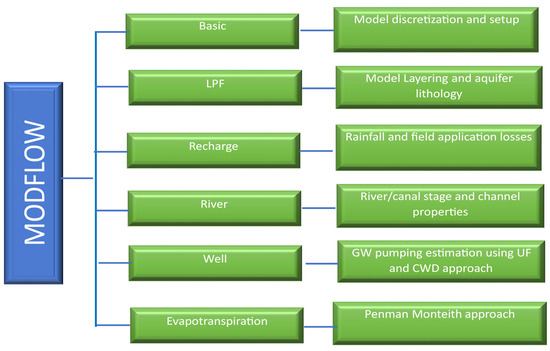
Figure 3.
The parameters used in model development.
2.4. Boundary and Initial Conditions for the Numerical Model
Boundary conditions can relate to groundwater inflows and outflows along the model’s boundaries on the one hand, or levels of the water table and hydraulic head along those boundaries on the other. In addition, the initial conditions refer to the initial values of components inside the model domain that may change over time and cover many of the same phenomena as the boundary conditions. The initial and boundary conditions may change depending on the location. In the current groundwater model, the river stage data was assigned to the river Ravi, Lower Bari Doab Canal (LBDC), and Sidhnai Mailsi Bahawal (SMB) link canal in a monthly stress period for a period from October 2010 to September 2020.
2.5. Aquifer Properties and Model Layering
The aquifer’s alluvial deposits are notably heterogeneous in both horizontal and vertical orientations. In spite of this, most people think of the aquifer as a single, continuous unit. Based on the boreholes dug by Water and Power Distribution Authority (WAPDA) in 1978, the average values of the hydraulic conductivity for the aquifer were estimated. The cross sections of four sites (one for each district) created in Golden Software Surfer 16.6 is shown in (Figure S1). The spatial variation of hydraulic conductivity (K), specific yield (Sy), and specific storage (Ss) are represented in Figure 4. Average hydraulic conductivity, specific yield, and specific storage values of the aquifer range from 11.1 to 71.5 m/day, 0.11 to 0.17, and 0.000071 to 0.00034 m−1, respectively. The model setup contains three layers with thicknesses of 30 m, 95 m, and 180 m for the top, middle, and bottom layers, respectively. The top layer was provided considering the max depth to water table (20 m). The thickness of middle layer was based on the maximum depth of bore in the area, while the bottom layer was extended to the bedrock of the aquifer.
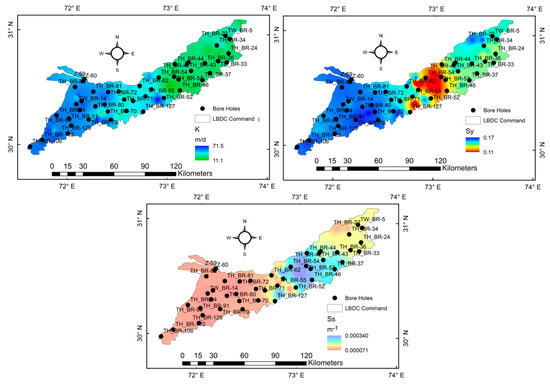
Figure 4.
Spatial distribution of K, Sy, and Ss in the LBDC command.
2.6. Groundwater Recharge
Groundwater recharge was incorporated from two major sources, i.e., rainfall recharge and field application losses. Field application losses were further bifurcated into surface water irrigation and pumping irrigation flow to groundwater. Suitable factors based on literature were used as a fraction contributing to groundwater [19]. The factors used for rainfall recharge (f1), canal irrigation (f2), and pumping return flow were 20, 25, and 25%, respectively (Equation (6)).
where f1, f2, and f3 are the percentage factors, Ri,j is rainfall in model cell, Ici,j is canal irrigation returns to model cell, and Ipi,j is pumping irrigation return to model cell.
2.7. Groundwater Pumping
Based on the nature of the available data, groundwater abstraction was estimated using the utilization factor (UF) method and crop water deficit (CWD) approach. Several parameters like operating pumping hours in a day, cropping season, bore diameter, and type of well were incorporated to calculate a utilization factor. The Punjab Bureau of Statistics documents the number of tubewells in each district of Punjab, and hence the total groundwater pumping was calculated for the total number of tubewells in the canal command using Equations (7) and (8).
Pumpage calculated through the utilization factor has a limitation in that it does not provide temporal pumpage; rather, it estimates a single value for a year. To counter the challenge, a monthly temporal change in evapotranspiration was utilized to estimate the monthly pumpage in the area. The size of each model grid is 1 km2 and includes an average of eight tubewells calculated by dividing the number of pumping wells by the active model cells.
For the crop water deficit approach, evapotranspiration, rainfall, and surface water supply parameters were used to estimate the pumping. Evapotranspiration data calculated through the Penman–Monteith equation, rainfall from the Pakistan Metrological Department, and canal supplies from the Punjab Irrigation Department were utilized for pumping estimation (Equation (9))
where ETa is the actual crop water requirement, SW is the surface water supply, and Peff is the effective rainfall. The average groundwater pumping calculated using the utilization factor against the number of tubewells and CWD was 4574 MCM and 4294 MCM, respectively, from 2010 to 2019 (Figure 5). Therefore, the pumping calculated through the CWD approach was utilized in the model as it provided better estimation.
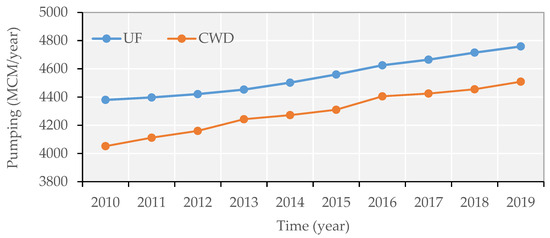
Figure 5.
Groundwater pumping comparison between UF and CWD approaches.
2.8. Stress Period and Time Step
The model was provided with 120 stress periods from October 2010 to September 2010. The length of each stress period was 30 days with 1 time step, which means the length of the stress periods and time steps was the same, i.e., 30 days. For both of the pumping scenarios, an additional 240 stress periods were added, which makes a total of 360 periods up to September 2040.
3. Results and Discussion
3.1. Spatio-Temporal Patterns of Climatology and Actual Evapotranspiration
The climate of LBDC command, based on long-term climatic data, is termed as hot to moderate summer and pleasant winter. Metrological records of Lahore, Okara, Sahiwal, and Multan stations suggested that the annual average maximum and minimum temperatures in the area are 31.4 °C and 18.5 °C, respectively. The annual average rainfall varies between 712 mm and 237 mm in Lahore and Multan, respectively. Spatio-temporal variation in minimum and maximum temperature and rainfall is shown below (Figure 6).
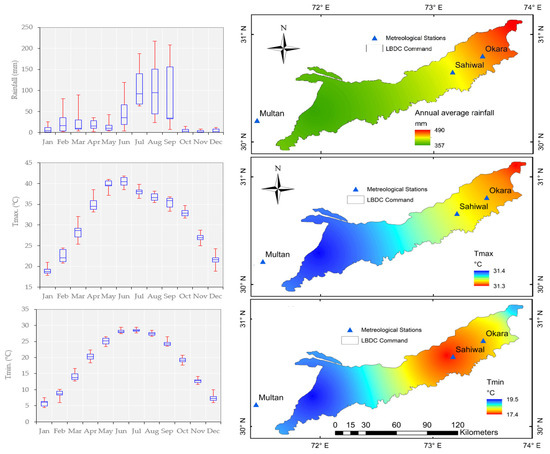
Figure 6.
Spatio-temporal variation in rainfall, Tmin and Tmax (2010–2020).
In the LBDC command area, a profound understanding of crop water requirements is indispensable for effective agricultural planning and efficient water resource management. A spatial distribution of decade-average ET for the five primary crops cultivated in this region—wheat, maize, cotton, rice, and sugarcane—is represented in Figure 7. Commencing with wheat, a staple winter cereal in the LBDC command region, it necessitates an annual average ET of 444 mm. The strategic application of irrigation during critical growth stages is paramount to augment yields and enhance grain quality. Maize, another prominent crop in the area, exhibits an annual average ET of 271 mm. As a warm-season cereal, maize mandates consistent moisture throughout its growth cycle to foster robust kernel development and maximize overall yield. Cotton, renowned as the principal cash crop, boasts an ET of 748 mm/year. Ensuring timely and sufficient irrigation is imperative to sustain its extended growth duration and bolster the production of premium-quality fibers. Rice, characterized by its high water dependency, registers a yearly ET of 975 mm. Typically cultivated in flooded fields, meticulous water management is essential to circumvent waterlogging while concurrently providing the requisite moisture for growth and grain maturation. Sugarcane, recognized as the most water-intensive crop in the region, exhibits an average annual ET of 1281 mm. Given its protracted growth season, sugarcane’s substantial water demands underscore the need for meticulous irrigation management. Spatially, ET values tend to escalate in the lower reaches, attributed to elevated temperatures and reduced rainfall. Notably, the area with relatively higher temperatures and distinct climatic factors manifests increasing ET values (Figure 7).
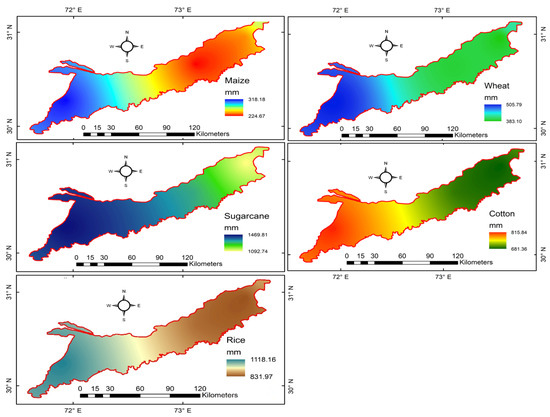
Figure 7.
Annual average crop water requirement of five major crops.
Moreover, we observe seasonal variations in ET (Figure 8). During the Rabi season, characterized by an average ET of 475 mm/year, the peak ET of 168 mm was recorded in December 2015. Conversely, in the Kharif season, marked by a notably higher average ET of 1102 mm/year, and the maximum ET of 226 mm was observed in June 2011. These variations in ET are influenced by the crops sown during each season and the prevailing climatic conditions (Figure 6) and also aligned with the findings of previous studies [64]. These findings provide critical insights into crop water requirements and seasonal dynamics, laying the foundation for informed decision-making in agriculture and water resource management [62,65].

Figure 8.
Average evapotranspiration for Rabi and Kharif seasons (2010–2020).
3.2. Spatio-Temporal Distribution of Depth to the Water Table in the LBDC
Analyzing the spatio-temporal distribution of water table depth in the LBDC command area revealed noteworthy trends (Figure 9). In the upper reaches, specifically Balloki and Okara, the rate of depletion was approximately 0.34 m/year. Conversely, in the lower reaches, encompassing Sahiwal and Khanewal, the water table exhibited a substantial decline at a rate of approximately 0.55 m/year. A clear illustration of this disparity is evident in Khanewal, where the average water table depth increased from 19.3 m in 2010 to 21.8 m in 2019 (Figure 9). This difference in water table dynamics between upper and lower reaches can be attributed to several factors. Notably, the upper reaches benefit from recharge through seepage from the main canal. In contrast, the lower reaches experience more significant declines due to reduced recharge resulting from seepage losses and higher rates of groundwater pumping [66]. Additionally, unequal distribution of surface water availability is a pivotal factor contributing to the observed variations in groundwater table depth across the LBDC command area [23,61]. The upstream farmers get more water from the surface channels as compared to lower reach farmers. The farmers in the tail of each distributary used ~40% of the total groundwater consumption [67], which caused a higher decline in the water table.
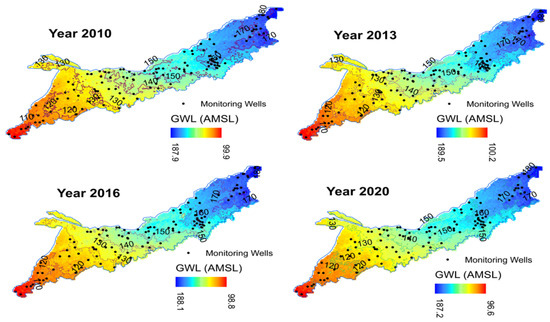
Figure 9.
Spatio-temporal variation in groundwater level from 2010 and 2020.
3.3. Model Calibration
The simulated water tables were compared to the observations for calibration of the MODFLOW model. A total of 29 field observations were used for calibration purposes. Factors 0.25, 0.5, 1.0, 1.25, 1.5, and 2.0 were used during the calibration. Hydraulic conductivity was found to be the most sensitive parameter during model calibration and the model was calibrated at a factor of 0.7 times the value of assigned hydraulic conductivity. The absolute residual mean, root mean square error (RMSE), and residual mean for calibration were 0.91, 1.21, and 0.03, respectively (Table 2). A plot between simulated and observed heads is shown in Figure 10. The applications of MODFLOW for groundwater table simulations has also been reported with reasonable accuracy in previous studies [68,69,70].

Table 2.
Statistical parameters for model evaluation.
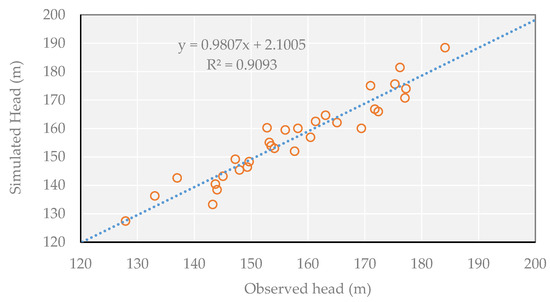
Figure 10.
Comparison between calculated and observed head for calibration.
3.4. Groundwater Budget
The water budget analysis encompassed four major components: river leakage, recharge (comprising rainfall and field application losses), groundwater pumping, and evapotranspiration. We simulated the water budget from October 2010 to September 2019 (Figure 11). The outcomes of the water balance analysis unveil the intricate interplay between various hydrological components. River and canal leakage were identified as crucial sources of recharge, collectively contributing 1586 MCM/year, which corresponds to 32% of the total recharge volume. Additionally, other sources, such as rainfall and field application losses, significantly bolstered the recharge, amounting to 3281 MCM/year and constituting a substantial 67% of the overall recharge. Groundwater extraction emerged as a predominant outflow component, with an estimated annual average of 4382 MCM/year. This voluminous extraction represents a substantial 89% of the total outflow from the hydrological model. Conversely, evapotranspiration, constrained by the deep-water table conditions, made a comparatively modest contribution, totaling 538 MCM/year. The intricate hydrological balance results in a net loss in aquifer storage, amounting to 53 MCM/year. Despite the theoretical availability of 53 MCM/year for extraction, it is imperative to exercise caution and refrain from tapping into this storage through pumping. Such actions would pose a significant threat to the long-term sustainability of the groundwater resource, warranting careful management and conservation measures.
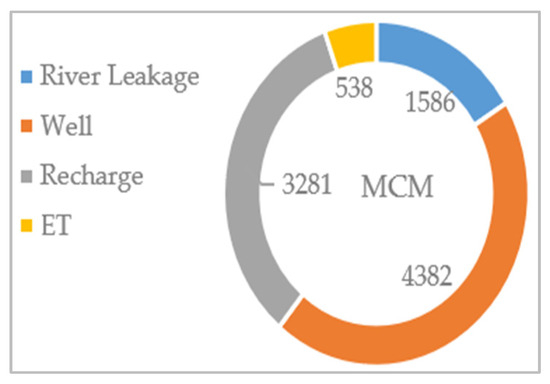
Figure 11.
Groundwater budget in LBDC command area (2010–2019). MCM (million cubic meter).
3.5. Groundwater Management Scenarios
3.5.1. 20% Increase in Groundwater Extraction by 2040
In the pursuit of sustainable groundwater management, two different scenarios were meticulously examined to gauge their potential implications on the LBDC command area’s hydrological equilibrium. The first scenario involved a substantial 20% increase in groundwater extraction by the year 2040. This adjustment was deemed necessary due to mounting pressures driven by escalating cropping intensity and a gradual reduction in surface water availability. While all other components of the water budget remained unaltered, this augmentation in groundwater extraction projected a significant surge in pumping rates, reaching 4650 MCM/year (Figure 12). However, this augmentation bore a noteworthy consequence, as the net water balance was adversely impacted. A considerable decline from the previous value of 53 MCM/year was observed, plunging to a deficit of −235 MCM/year. Furthermore, to provide a comprehensive understanding of the ramifications of this scenario, Figure 13 illustrates a plot depicting the simulated versus observed groundwater levels in select observation wells. An irreversible decline in water table trends up to 2040 was observed for all selected observational wells. These trends underscore the pivotal importance of prudent groundwater management strategies to maintain equilibrium and safeguard against impending challenges in the coming decades.

Figure 12.
Average GW budget for 20% increase in pumping up to 2040.
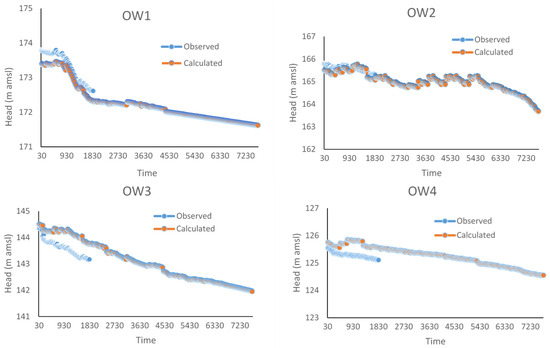
Figure 13.
Simulated heads (MSL) for 20% increase in groundwater extraction by 2040—time step on x-axis is monthly. (The longitude and latitude of the OW1 (368089.2, 3436025), OW2 (345518.1, 3391228), OW3 (263012.9, 3383686), and OW4 (236519.2, 3351202) in UTM).
3.5.2. 20% Decrease in Groundwater Extraction up to September 2040
In an alternative groundwater management scenario aimed at achieving a more sustainable equilibrium, a deliberate 20% reduction in groundwater pumping was contemplated, extending up to September 2040. This strategy was contingent upon the regulation of tube wells and the potential development of storage structures, while keeping all other water budget components unchanged. The outcomes of this reduction were significant, resulting in a notable decline in groundwater pumping rates, which plummeted to 4125 MCM/year (Figure 14). More importantly, this measure yielded a positive impact on the net water balance, significantly ameliorating the situation from the previous value of 53 MCM/year to a commendable surplus of 291 MCM/year.

Figure 14.
Average GW budget for a 20% decrease in pumping up to 2040.
The time series comparing simulated and observed groundwater levels in select observation wells during 2010–2020 and projected results until 2040 are represented in Figure 15. Results indicated a decreasing trend in water table decline between 2020 and 2040. Ref. [71] reported that 20% recharging to the aquifer would increase the water supply capacity for irrigation by 70% in projected periods. Our findings underscore the efficacy of proactive groundwater management strategies, offering a promising avenue for safeguarding the long-term sustainability of groundwater resources in the LBDC command area.
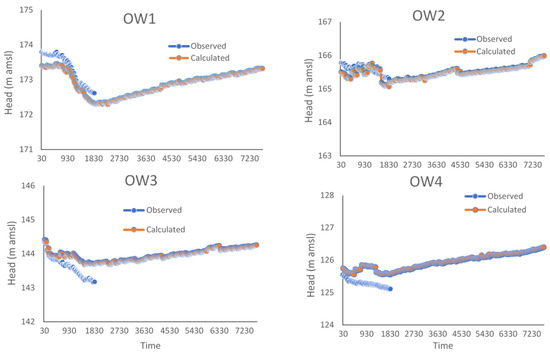
Figure 15.
Simulated heads (MSL) for 20% decrease in groundwater extraction up to September 2040—time step on x-axis is monthly. (The longitude and latitude of the OW1 (368089.2, 3436025), OW2 (345518.1, 3391228), OW3 (263012.9, 3383686), and OW4 (236519.2, 3351202) in UTM).
3.6. Limitations and Future Work
Despite the comprehensive assessment of groundwater dynamics, key limitations still exist in this work. Firstly, the availability of meteorological data from specific monitoring stations within the LBDC command area restricted the spatial coverage of climate data. Expanding the network of weather stations and acquiring more extensive datasets would enhance the accuracy of future analyses. Additionally, this study primarily focused on groundwater quantity and dynamics, with limited consideration of groundwater quality. Future investigations should incorporate a thorough assessment of groundwater quality, given its pivotal role in sustainable water resource management. Furthermore, this study assumed constant aquifer properties, potentially overlooking variations in aquifer characteristics. Incorporating these variations into models would improve the representation of real-world conditions. Future research should endeavor to develop integrated hydrogeological models that encompass both groundwater quantity and quality, providing a more holistic assessment of water resources in the LBDC command area. Consideration of the potential impacts of climate change, such as altered precipitation patterns and temperatures, on groundwater dynamics and crop water requirements is crucial. Tailored groundwater management strategies should be explored for different regions within the LBDC command, accounting for unique hydrogeological conditions and socio-economic factors. The development of policy frameworks and management guidelines that promote sustainable groundwater use, equitable water distribution, and responsible agricultural practices is essential.
4. Conclusions
This study rigorously estimated crop water requirements using the Penman–Monteith equation and meticulously analyzed groundwater dynamics from October 2010 to September 2019 using a comprehensive three-dimensional groundwater model. Key findings include significant disparities in crop water needs between upper (Balloki and Okara) and lower (Sahiwal and Khanewal) reaches, averaging 891 mm/year and 1170 mm/year, respectively. Notably, the lower reaches experienced a faster groundwater table decline at 0.55 m/year compared to 0.34 m/year in the upper reaches. The observed annual average recharge from river and canal leakage was 1586 MCM/year, complemented by 3281 MCM/year from other sources. Groundwater extraction averaged 4382 MCM/year, emphasizing its pivotal role in the water balance. Projections for a 20% increase in groundwater pumping until September 2040 indicated accelerated declines in groundwater levels, reaching rates of 0.51 m/year in the upper reaches and 0.74 m/year in the lower reaches. Conversely, a 20% decrease in pumping led to an enhanced net storage of 291 MCM/year from the previous 53 MCM/year.
These findings, underpinned by rigorous modeling and analysis, bear far-reaching implications. They proffer invaluable guidance for policymakers, water resource managers, and researchers, collectively fostering concerted efforts to combat groundwater depletion, secure long-term agricultural viability, fortify overall water security, and ultimately confer the benefits onto the farming community. Moreover, we advocate for future research endeavors that delve into water quality concerns through solute transport modeling, thereby paving the way for an integrated approach to tackle the dual challenges of declining groundwater levels and water quality. Such holistic endeavors hold the potential to usher in sustainable groundwater development, thereby enhancing the livelihoods of farming communities and the resilience of this vital resource.
Supplementary Materials
The following supporting information can be downloaded at: https://www.mdpi.com/2073-4441/16/1/34/s1, Figure S1. Cross sectional view of boreholes, one for each of the four districts of the study area.
Author Contributions
A.R.: Analysis; A.R. and A.A.: Writing draft; I.A.: Supervision & Conceptualization; A.A., M.S. (Muhammad Saifullah), M.S. (Muhammad Shafeeque) and J.L.: Writing—Review and Editing; M.S. (Muhammad Saifullah), Z.U.R., M.M.R. and U.I.: Visualization. All authors have read and agreed to the published version of the manuscript.
Funding
This research received no external funding.
Data Availability Statement
We are thankful to the Punjab Irrigation Department (PID: https://irrigation.punjab.gov.pk/: access date 21 January 2023) and Pakistan Metrological Department (PMD: https://www.pmd.gov.pk/en/: access date 21 January 2023) for providing the data for flows, head gauges, and climatic parameters utilized to meet the research objectives effectively. No external output data is generated from this research except that used in supporting the results and analysis in the article.
Conflicts of Interest
The authors declare no conflict of interest.
Correction Statement
This article has been republished with a minor correction to the existing affiliation information. This change does not affect the scientific content of the article.
References
- Griebler, C.; Avramov, M. Groundwater ecosystem services: A review. Freshw. Sci. 2015, 34, 355–367. [Google Scholar] [CrossRef]
- Aliabad, F.A.; Hakimzadeh, M.A.; Shojaei, S. The impact of drought and decline in groundwater levels on the spread of sand dunes in the plain in Iran. Sustain. Water Resour. Manag. 2019, 5, 541–555. [Google Scholar] [CrossRef]
- Scanlon, B.; Zhang, Z.; Rateb, A.; Sun, A.; Wiese, D.; Save, H.; Beaudoing, H.; Lo, M.; Müller-Schmied, H.; Döll, P. Tracking seasonal fluctuations in land water storage using global models and GRACE satellites. Geophys. Res. Lett. 2019, 46, 5254–5264. [Google Scholar] [CrossRef]
- Mohan, C.; Gleeson, T.; Forstner, T.; Famiglietti, J.S.; de Graaf, I. Quantifying Groundwater’s Contribution to Regional Environmental-Flows in Diverse Hydrologic Landscapes. Water Resour. Res. 2023, 59, e2022WR033153. [Google Scholar] [CrossRef]
- Siebert, S.; Burke, J.; Faures, J.-M.; Frenken, K.; Hoogeveen, J.; Döll, P.; Portmann, F.T. Groundwater use for irrigation—A global inventory. Hydrol. Earth Syst. Sci. 2010, 14, 1863–1880. [Google Scholar] [CrossRef]
- Khafaji, M.S.A.; Alwan, I.A.; Khalaf, A.G.; Bhat, S.A.; Kuriqi, A. Potential use of groundwater for irrigation purposes in the Middle Euphrates region, Iraq. Sustain. Water Resour. Manag. 2022, 8, 157. [Google Scholar] [CrossRef]
- Marston, L.; Konar, M.; Cai, X.; Troy, T.J. Virtual groundwater transfers from overexploited aquifers in the United States. Proc. Natl. Acad. Sci. USA 2015, 112, 8561–8566. [Google Scholar] [CrossRef]
- Siebert, S.; Döll, P. Quantifying blue and green virtual water contents in global crop production as well as potential production losses without irrigation. J. Hydrol. 2010, 384, 198–217. [Google Scholar] [CrossRef]
- Boretti, A.; Rosa, L. Reassessing the projections of the world water development report. NPJ Clean. Water 2019, 2, 15. [Google Scholar] [CrossRef]
- Faquseh, H.; Grossi, G. The effect of climate change on groundwater resources availability: A case study in the city of Brescia, northern Italy. Sustain. Water Resour. Manag. 2023, 9, 113. [Google Scholar] [CrossRef]
- Warku, F.; Korme, T.; Wedajo, G.K.; Nedow, D. Impacts of land use/cover change and climate variability on groundwater recharge for upper Gibe watershed, Ethiopia. Sustain. Water Resour. Manag. 2022, 8, 2. [Google Scholar] [CrossRef]
- Haddeland, I.; Heinke, J.; Biemans, H.; Eisner, S.; Flörke, M.; Hanasaki, N.; Konzmann, M.; Ludwig, F.; Masaki, Y.; Schewe, J. Global water resources affected by human interventions and climate change. Proc. Natl. Acad. Sci. USA 2014, 111, 3251–3256. [Google Scholar] [CrossRef]
- Asadi, R.; Zamaniannejatzadeh, M.; Eilbeigy, M. Assessing the Impact of Human Activities and Climate Change Effects on Groundwater Quantity and Quality: A Case Study of the Western Varamin Plain, Iran. Water 2023, 15, 3196. [Google Scholar] [CrossRef]
- Taylor, R.G.; Scanlon, B.; Döll, P.; Rodell, M.; Van Beek, R.; Wada, Y.; Longuevergne, L.; Leblanc, M.; Famiglietti, J.S.; Edmunds, M. Ground water and climate change. Nat. Clim. Chang. 2013, 3, 322–329. [Google Scholar] [CrossRef]
- Ashraf, S.; Ali, M.; Shrestha, S.; Hafeez, M.A.; Moiz, A.; Sheikh, Z.A. Impacts of climate and land-use change on groundwater recharge in the semi-arid lower Ravi River basin, Pakistan. Groundw. Sustain. Dev. 2022, 17, 100743. [Google Scholar] [CrossRef]
- Wada, Y.; Van Beek, L.P.; Van Kempen, C.M.; Reckman, J.W.; Vasak, S.; Bierkens, M.F. Global depletion of groundwater resources. Geophys. Res. Lett. 2010, 37, L20402. [Google Scholar] [CrossRef]
- Gleeson, T.; Cuthbert, M.; Ferguson, G.; Perrone, D. Global groundwater sustainability, resources, and systems in the Anthropocene. Annu. Rev. Earth Planet. Sci. 2020, 48, 431–463. [Google Scholar] [CrossRef]
- Kaur, N.; Kaur, S.; Kaur, P.; Aggarwal, R. Impact of climate change on groundwater levels in Sirhind Canal Tract of Punjab, India. Groundw. Sustain. Dev. 2021, 15, 100670. [Google Scholar] [CrossRef]
- Kaur, N.; Kaur, S.; Tsolakis, N.; Mishra, N.; Srai, J.S. Managing groundwater demand through surface water and reuse strategies in an overexploited aquifer of Indian Punjab. Model. Earth Syst. Environ. 2023, 9, 2009–2026. [Google Scholar] [CrossRef]
- Zeydalinejad, N.; Mahdavikia, H.; Goudarzi, A.; Saeidi, S. The present challenges and policy for sustainable management of groundwater resources in Iran: Putting emphasis on Lorestan province as an example in the country. Sustain. Water Resour. Manag. 2023, 9, 95. [Google Scholar] [CrossRef]
- Famiglietti, J.S. The global groundwater crisis. Nat. Clim. Chang. 2014, 4, 945–948. [Google Scholar] [CrossRef]
- Sidhu, B.S.; Sharda, R.; Singh, S. Spatio-temporal assessment of groundwater depletion in Punjab, India. Groundw. Sustain. Dev. 2021, 12, 100498. [Google Scholar] [CrossRef]
- Arshad, A.; Mirchi, A.; Samimi, M.; Ahmad, B. Combining downscaled-GRACE data with SWAT to improve the estimation of groundwater storage and depletion variations in the irrigated Indus basin. Sci. Total Environ. 2022, 838, 156044. [Google Scholar] [CrossRef] [PubMed]
- Ali, S.; Khorrami, B.; Jehanzaib, M.; Tariq, A.; Ajmal, M.; Arshad, A.; Shafeeque, M.; Dilawar, A.; Basit, I.; Zhang, L. Spatial downscaling of GRACE data based on XGBoost model for improved understanding of hydrological droughts in the Indus Basin Irrigation System (IBIS). Remote Sens. 2023, 15, 873. [Google Scholar] [CrossRef]
- Ali, S.; Liu, D.; Fu, Q.; Cheema, M.J.M.; Pal, S.C.; Arshad, A.; Pham, Q.B.; Zhang, L. Constructing high-resolution groundwater drought at spatio-temporal scale using GRACE satellite data based on machine learning in the Indus Basin. J. Hydrol. 2022, 612, 128295. [Google Scholar] [CrossRef]
- Ali, S.; Liu, D.; Fu, Q.; Cheema, M.J.M.; Pham, Q.B.; Rahaman, M.; Dang, T.D.; Anh, D.T. Improving the Resolution of GRACE Data for Spatio-Temporal Groundwater Storage Assessment. Remote Sens. 2021, 13, 3513. [Google Scholar] [CrossRef]
- Ali, S.; Wang, Q.; Liu, D.; Fu, Q.; Rahaman, M.M.; Faiz, M.A.; Cheema, M.J.M. Estimation of spatio-temporal groundwater storage variations in the Lower Transboundary Indus Basin using GRACE satellite. J. Hydrol. 2022, 605, 127315. [Google Scholar] [CrossRef]
- Laghari, A.N.; Vanham, D.; Rauch, W. The Indus basin in the framework of current and future water resources management. Hydrol. Earth Syst. Sci. 2012, 16, 1063–1083. [Google Scholar] [CrossRef]
- Ahmed, I.; ur Rahman, M.H.; Ahmed, S.; Hussain, J.; Ullah, A.; Judge, J. Assessing the impact of climate variability on maize using simulation modeling under semi-arid environment of Punjab, Pakistan. Environ. Sci. Pollut. Res. 2018, 25, 28413–28430. [Google Scholar] [CrossRef]
- Adnan, S.; Ullah, K.; Gao, S.; Khosa, A.H.; Wang, Z. Shifting of agro-climatic zones, their drought vulnerability, and precipitation and temperature trends in Pakistan. Int. J. Climatol. 2017, 37, 529–543. [Google Scholar] [CrossRef]
- Qureshi, A.S. Groundwater governance in Pakistan: From colossal development to neglected management. Water 2020, 12, 3017. [Google Scholar] [CrossRef]
- Karimi, P.; Bastiaanssen, W.; Molden, D.; Cheema, M. Basin-wide water accounting using remote sensing data: The case of transboundary Indus Basin. Hydrol. Earth Syst. Sci. Discuss. 2012, 9, 12921–12958. [Google Scholar]
- Basharat, M. Spatial and temporal appraisal of groundwater depth and quality in LBDC command-issues and options. Pak. J. Eng. Appl. Sci. 2012, 11, 14–29. [Google Scholar]
- Smolenaars, W.J.; Dhaubanjar, S.; Jamil, M.K.; Lutz, A.; Immerzeel, W.; Ludwig, F.; Biemans, H. Future upstream water consumption and its impact on downstream water availability in the transboundary Indus Basin. Hydrol. Earth Syst. Sci. 2022, 26, 861–883. [Google Scholar] [CrossRef]
- Zakir-Hassan, G.; Punthakey, J.F.; Shabir, G.; Yasmeen, F.; Sultan, M.; Ashraf, H.; Sohoo, I.; Majeed, F. Physicochemical investigation of rainfall for managed aquifer recharge in Punjab (Pakistan). Water 2022, 14, 2155. [Google Scholar] [CrossRef]
- Akhter, G.; Ge, Y.; Iqbal, N.; Shang, Y.; Hasan, M. Appraisal of remote sensing technology for groundwater resource management perspective in Indus Basin. Sustainability 2021, 13, 9686. [Google Scholar] [CrossRef]
- Masood, A.; Tariq, M.A.U.R.; Hashmi, M.Z.U.R.; Waseem, M.; Sarwar, M.K.; Ali, W.; Farooq, R.; Almazroui, M.; Ng, A.W. An overview of groundwater monitoring through point-to satellite-based techniques. Water 2022, 14, 565. [Google Scholar] [CrossRef]
- Božiček, B.; Lojen, S.; Dolenec, M.; Vižintin, G. Impacts of deep groundwater monitoring wells on the management of deep geothermal Pre-Neogene aquifers in the Mura-Zala Basin, Northeastern Slovenia. Groundw. Sustain. Dev. 2017, 5, 193–205. [Google Scholar] [CrossRef]
- Gayen, A. Field-based spatio-temporal monitoring of hydrograph network stations to predict the long-term behavioral pattern of groundwater regime and its implications in India: A review. Case Stud. Geospat. Appl. Groundw. Resour. 2023, 171–183. [Google Scholar] [CrossRef]
- Asgharinia, S.; Petroselli, A. A comparison of statistical methods for evaluating missing data of monitoring wells in the Kazeroun Plain, Fars Province, Iran. Groundw. Sustain. Dev. 2020, 10, 100294. [Google Scholar] [CrossRef]
- Mengistu, H.A.; Demlie, M.B.; Abiye, T.A.; Xu, Y.; Kanyerere, T. Conceptual hydrogeological and numerical groundwater flow modelling around the Moab Khutsong deep gold mine, South Africa. Groundw. Sustain. Dev. 2019, 9, 100266. [Google Scholar] [CrossRef]
- Aliewi, A.; Bhandary, H.; Al-Qallaf, H.; Sabarathinam, C.; Al-Kandari, J. Assessment of the groundwater yield and sustainability of the transboundary Dibdibba aquifer using numerical modelling approach. Groundw. Sustain. Dev. 2021, 15, 100678. [Google Scholar] [CrossRef]
- Leão, B.R.; Junior, G.C.S.; Eger, G.Z.; Marques, E.A. Numerical modeling as a support tool for groundwater permits in the state of Bahia, Brazil. Groundw. Sustain. Dev. 2023, 23, 100986. [Google Scholar] [CrossRef]
- Liang, F.; Li, S.; Jie, F.; Ge, Y.; Liu, N.; Jia, G. The Development of a Coupled Soil Water Assessment Tool-MODFLOW Model for Studying the Impact of Irrigation on a Regional Water Cycle. Water 2023, 15, 3542. [Google Scholar] [CrossRef]
- Wang, S.; Shao, J.; Song, X.; Zhang, Y.; Huo, Z.; Zhou, X. Application of MODFLOW and geographic information system to groundwater flow simulation in North China Plain, China. Environ. Geol. 2008, 55, 1449–1462. [Google Scholar] [CrossRef]
- Singh, R.; Chakma, S.; Birke, V. Numerical modelling and performance evaluation of multi-permeable reactive barrier system for aquifer remediation susceptible to chloride contamination. Groundw. Sustain. Dev. 2020, 10, 100317. [Google Scholar] [CrossRef]
- Yadav, R.; Roy, J. Analytical solutions of one-dimensional scale dependent advection-dispersion equations for finite domain solute transport. Groundw. Sustain. Dev. 2022, 16, 100712. [Google Scholar] [CrossRef]
- Zdechlik, R. A review of applications for numerical groundwater flow modeling. Int. Multidiscip. Sci. GeoConference SGEM 2016, 3, 11–18. [Google Scholar]
- Karmakar, S.; Tatomir, A.; Oehlmann, S.; Giese, M.; Sauter, M. Numerical Benchmark Studies on Flow and Solute Transport in Geological Reservoirs. Water 2022, 14, 1310. [Google Scholar] [CrossRef]
- Chen, H.; Xue, Y.; Qiu, D. Numerical simulation of the land subsidence induced by groundwater mining. Clust. Comput. 2022, 26, 3647–3656. [Google Scholar] [CrossRef]
- Hamdi, M.; Goïta, K. Analysis of Groundwater Depletion in the Saskatchewan River Basin in Canada from Coupled SWAT-MODFLOW and Satellite Gravimetry. Hydrology 2023, 10, 188. [Google Scholar] [CrossRef]
- Mosase, E.; Ahiablame, L.; Park, S.; Bailey, R. Modelling potential groundwater recharge in the Limpopo River Basin with SWAT-MODFLOW. Groundw. Sustain. Dev. 2019, 9, 100260. [Google Scholar] [CrossRef]
- Talebmorad, H.; Ostad-Ali-Askari, K. Hydro geo-sphere integrated hydrologic model in modeling of wide basins. Sustain. Water Resour. Manag. 2022, 8, 118. [Google Scholar] [CrossRef]
- Di Salvo, C. Improving results of existing groundwater numerical models using machine learning techniques: A review. Water 2022, 14, 2307. [Google Scholar] [CrossRef]
- Leaf, A.T.; Fienen, M.N. Modflow-setup: Robust automation of groundwater model construction. Front. Earth Sci. 2022, 10, 903965. [Google Scholar] [CrossRef]
- Qadir, A.; Ahmad, Z.; Khan, T.; Zafar, M.; Qadir, A.; Murata, M. A spatio-temporal three-dimensional conceptualization and simulation of Dera Ismail Khan alluvial aquifer in visual MODFLOW: A case study from Pakistan. Arab. J. Geosci. 2016, 9, 1–9. [Google Scholar]
- Shakoor, A.; Arshad, M.; Ahmad, R.; Khan, Z.M.; Qamar, U.; Farid, H.U.; Sultan, M.; Ahmad, F. Development of groundwater flow model (MODFLOW) to simulate the escalating groundwater pumping in the Punjab, Pakistan. Pak. J. Agric. Sci. 2018, 55, 629–638. [Google Scholar]
- Aslam, M.; Arshad, M.; Singh, V.P.; Shahid, M.A. Hydrological Modeling of Aquifer’s Recharge and Discharge Potential by Coupling WetSpass and MODFLOW for the Chaj Doab, Pakistan. Sustainability 2022, 14, 4421. [Google Scholar] [CrossRef]
- Aslam, M.; Shehzad, M.U.; Ali, A.; Ali, N.; Chaiyasan, K.; Tahir, H.; Joyklad, P.; Hussain, Q. Seepage and Groundwater Numerical Modelling for Managing Waterlogging in the Vicinity of the Trimmu–Sidhnai Link Canal. Infrastructures 2022, 7, 144. [Google Scholar] [CrossRef]
- Aslam, R.A.; Shrestha, S.; Usman, M.N.; Khan, S.N.; Ali, S.; Sharif, M.S.; Sarwar, M.W.; Saddique, N.; Sarwar, A.; Ali, M.U. Integrated SWAT-MODFLOW Modeling-Based Groundwater Adaptation Policy Guidelines for Lahore, Pakistan under Projected Climate Change, and Human Development Scenarios. Atmosphere 2022, 13, 2001. [Google Scholar] [CrossRef]
- Arfan Arshad, A.M.; Perez, J.V.; Akbar, M.U.; Madani, K. Reconstructing high-resolution groundwater level data using a hybrid random forest model to quantify distributed groundwater changes in the Indus Basin. J. Hydrol. 2023, 628, 130535. [Google Scholar] [CrossRef]
- Hussain, S.; Mubeen, M.; Nasim, W.; Fahad, S.; Ali, M.; Ehsan, M.A.; Raza, A. Investigation of Irrigation Water Requirement and Evapotranspiration for Water Resource Management in Southern Punjab, Pakistan. Sustainability 2023, 15, 1768. [Google Scholar] [CrossRef]
- Rahman, M.; Islam, M.; Hasanuzzaman, M. Study of effective rainfall for irrigated agriculture in south-eastern part of Bangladesh. World J. Agric. Sci. 2008, 4, 453–457. [Google Scholar]
- Arshad, A.; Zhang, Z.; Zhang, W.; Gujree, I. Long-term perspective changes in crop irrigation requirement caused by climate and agriculture land use changes in Rechna Doab, Pakistan. Water 2019, 11, 1567. [Google Scholar] [CrossRef]
- Shafeeque, M.; Bibi, A. Assessing the Impact of Future Climate Scenarios on Crop Water Requirements and Agricultural Water Supply Across Different Climatic Zones of Pakistan. Front. Earth Sci. 2023, 11, 1283171. [Google Scholar] [CrossRef]
- Schmid, W.; Punthakey, J.; Hodgson, G.; Kirby, M.; Ahmad, M.; Podger, G.; Stewart, J.; Basharat, M.; Khero, Z.; Bodla, H. Development of a Regional Groundwater Model for the Indus Basin Irrigation System of Pakistan. South Asia Sustainable Development Investment Portfolio (SDIP) Project. CSIRO, Australia. 2017. Available online: https://www.researchgate.net/publication/321500430_Development_of_a_regional_groundwater_model_for_the_Indus_Basin_irrigation_system_of_Pakistan_Status_report (accessed on 15 December 2023).
- Awan, U.K.; Anwar, A.; Ahmad, W.; Hafeez, M. A methodology to estimate equity of canal water and groundwater use at different spatial and temporal scales: A geo-informatics approach. Environ. Earth Sci. 2016, 75, 409. [Google Scholar] [CrossRef]
- Liu, Y.; Jiang, Y.; Zhang, S.; Wang, D.; Chen, H. Application of a Linked Hydrodynamic–Groundwater Model for Accurate Groundwater Simulation in Floodplain Areas: A Case Study of Irtysh River, China. Water 2023, 15, 3059. [Google Scholar] [CrossRef]
- Ware, H.H.; Mengistu, T.D.; Yifru, B.A.; Chang, S.W.; Chung, I.-M. Assessment of Spatiotemporal Groundwater Recharge Distri-bution Using SWAT-MODFLOW Model and Transient Water Fluctuation Method. Water 2023, 15, 2112. [Google Scholar] [CrossRef]
- Hassan, W.H.; Ghanim, A.A.; Mahdi, K.; Adham, A.; Mahdi, F.A.; Nile, B.K.; Riksen, M.; Ritsema, C. Effect of Artificial (Pond) Recharge on the Salinity and Groundwater Level in Al-Dibdibba Aquifer in Iraq Using Treated Wastewater. Water 2023, 15, 695. [Google Scholar] [CrossRef]
- Shafeeque, M.; Hafeez, M.; Sarwar, A.; Arshad, A.; Khurshid, T.; Asim, M.I.; Ali, S.; Dilawar, A. Quantifying future water-saving potential under climate change and groundwater recharge scenarios in Lower Chenab Canal, Indus River Basin. Theor. Appl. Climatol. 2023, 1–18. [Google Scholar] [CrossRef]
Disclaimer/Publisher’s Note: The statements, opinions and data contained in all publications are solely those of the individual author(s) and contributor(s) and not of MDPI and/or the editor(s). MDPI and/or the editor(s) disclaim responsibility for any injury to people or property resulting from any ideas, methods, instructions or products referred to in the content. |
© 2023 by the authors. Licensee MDPI, Basel, Switzerland. This article is an open access article distributed under the terms and conditions of the Creative Commons Attribution (CC BY) license (https://creativecommons.org/licenses/by/4.0/).